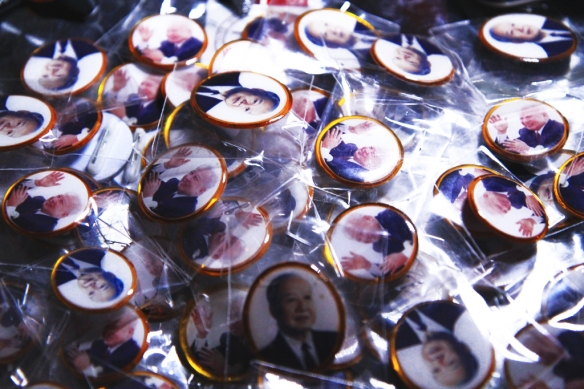I went to the “old hacks” panel at Meta House last night. Allow me to crib from the Meta House schedule regarding who was there:
James Gerrand / filmmaker (The Prince and The Prophecy)
* Roland Neveu / photographer, who covered the fall of Phnom Penh
* James Pringle / AP correspondent, who covered the Cambodian civil war
* Tim Page / legendary photo journalist, author and publisher
A 1979 Frontline documentary about legendary combat cameraman Neil Davis came first. Davis was one of the few Vietnam war-era journalists who went with the South Vietnamese soldiers.
Mostly I remember the bit with the footage omitted: a Vietnamese neutral was attempting to cross to the American side of the conflict, waving a piece of some kind of white fabric.
A US sergeant shouted “Bullshit! Cut him down!” And the soldiers did.
The footage, according to the Canadian Journal of Communications, somehow vanished: the audio tape nearly got the Australian expelled from South Vietnam.
Davis was hit with shrapnel and killed in the 1985 Bangkok coup. But he is remembered.
A huge pack of journalists and looker-ons filled up the Meta House conference space for the panel discussion that followed the film. I was both jet-lagged and had forgotten to eat for more days then is advisable, so I’ll admit now this probably isn’t the most accurate account. But certainly a lot of what was said stuck with me.
“Does anybody remember pictures from Kosovo? Does anybody remember Iraq?” asked legendary war photographer Tim Page. “Everyone remembers the Pulitzers from Vietnam.”
“You’d have to get your head examined if you wanted to enter this industry now,” he added, but then went on.
“You have to get that picture because it makes you proud, not some editor.”
They talked about why anyone would do what they do. Maybe it was the urge to be a hero. To escape the quiet confines of the suburbs to see what life is really like, out there on the edge.
Not just men, nowadays, but women too. A weird impulse, but also one that is well-nigh impossible to deny if you’ve been infected. The urge to get closer to the proverbial bang-bang, even when it means seeing your friends die.
It’s the acknowledgement of the semi-holy power of a really great picture. Social change has been wrought on the back of powerful photographs. They are taught in schools, burned into the minds of children. This is a good reason to do what they do.
A Cambodian woman asked why the Vietnamese waited until 1979 to invade Cambodia. An anti-war activist spoke up, too — reminding me that I’d never really contemplate the perhaps interesting relationship between anti-war types and war photographers themselves. Without war, there is no war photography, after all — but when exactly will there be no war?
As the journalists spoke, gunfire from the Riverside, commemorating Sihanouk, blasted far off in the distance.
Don North, a Vietnam journalist, spoke fondly of Sihanouk. He’d followed him around for a month in 1964, working on a documentary. “He was one of the best interviews ever,” he said sadly. He’d been standing very near the coffin as it burned on Monday.
Here’s an excellent multimedia presentation on the war correspondents who covered the fighting between 1970 and 1975, via the Phnom Penh Post:

